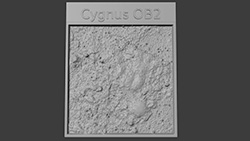CXC Home | Search | Help | Image Use Policy | Latest Images | Privacy | Accessibility | Glossary | Q&A
1
X-ray & Optical Images of Cygnus OB2Credit: X-ray: NASA/CXC/SAO/J. Drake et al, IR: NASA/JPL-Caltech/Spitzer; Image Processing: NASA/CXC/SAO/N. Wolk
In the Cygnus OB2 star cluster, giant stars send out large amounts of high-energy radiation that can disrupt relatively fragile disks of dust and gas that are in the process of coalescing to form new planets. These images show Chandra data detailing the diffuse X-ray emission and young stars, with infrared data from Spitzer revealing young stars and the cooler dust and gas throughout the region. These data were used to create the best census of young stars in the cluster.
2
3D Printable Files: Cygnus OB2(3D Print Credit: NASA/CXC/A. Jubett, using software by Tactile Universe/N. Bonne & C. Krawczyk & Blender)
This tactile plate is a physical relief map based on the intensity of X-ray and infrared data, featuring the Cygnus OB2 star cluster, which resembles a night sky blanketed in hazy fog and feathery clouds.
The center of the plate is dominated by raised hazy lumps, smoother than the more speckled edges. These hazy lumps represent diffuse X-ray emissions, and young stars, detected by the Chandra X-ray observatory. Surrounding the haze is a mottled, streaky, raised cloud. Another raised cloud stretches from the lower left to the center of the plate. These clouds represent relatively cool dust and gas observed by the Spitzer Space Telescope.
The center of the plate is dominated by raised hazy lumps, smoother than the more speckled edges. These hazy lumps represent diffuse X-ray emissions, and young stars, detected by the Chandra X-ray observatory. Surrounding the haze is a mottled, streaky, raised cloud. Another raised cloud stretches from the lower left to the center of the plate. These clouds represent relatively cool dust and gas observed by the Spitzer Space Telescope.
Return to: Planets Beware: NASA Unburies Danger Zones of Star Cluster (October 28, 2024)









